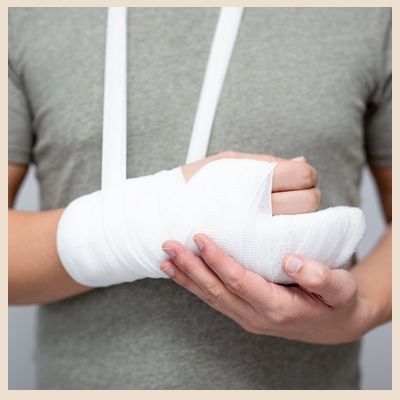

A fracture is a broken bone. It can range from a thin crack to a complete break. Bone can fracture crosswise, lengthwise, in several places, or into many pieces. Most fractures happen when a bone is impacted by more force or pressure than it can support.
There is a range of fracture types, including:
When a large bone is affected, such as the pelvis or femur:
If possible, do not move a person with a broken bone until a healthcare professional is present and can assess the situation and, if required, apply a splint. If the patient is in a dangerous place, such as in the middle of a busy road, one sometimes has to act before the emergency services arrive.
Most fractures are caused by a bad fall or automobile accident. Healthy bones are extremely tough and resilient and can withstand surprisingly powerful impacts. As people age, two factors make their risk of fractures greater: Weaker bones and a greater risk of falling.
Children, who tend to have more physically active lifestyles than adults, are also prone to fractures.
People with underlying illnesses and conditions that may weaken their bones have a higher risk of fractures. Examples include osteoporosis, infection, or a tumor. As mentioned earlier, this type of fracture is known as a pathological fracture.
Stress fractures, which result from repeated stresses and strains, commonly found among professional sports people, are also common causes of fractures.
Homeopathic medicines not only offer respite to the pain but also provide a holistic cure for the emotional anxiety one goes through in such times. Many therefore seek out homeopathic remedies for treating bone fractures. Some of the most effective antidotes in this regard have been enlisted below.
1. Arnica: Arnica is extremely helpful at curbing swelling and as a consequence, reducing pain. The prolonged use of Arnica can potentially minimize the swelling to absolute normalcy.
2. Hypericum: Powerful homeopathic medicine for bone fracture soothes the fracture induced pains, especially when the fractures affect the nerves. This is a beneficial remedy for fractures in fingers, toes, and the spinal regions. Must Have products for healthy bones & joints
3. Bryonia: Bryonia is known to bring relief in cases of the jarring pain that surfaces post-trauma. Sometimes, even the slightest movement in the affected area can lead to a lot of distress. This is an ideal cure for such cases.
4. Calcarea Phosphorica: This homeopathic remedy for bone fracture speeds up the healing process following a bone fracture. Consumption of Calcarea Phosphorica accords a calming effect on the moods of the patient and helps to deal better with the pain, anxiety, and irritability in the due course.
5. Eupatorium Perfoliatum: This fracture homeopathic medicine helps in mitigating deep wounds and the consequent aches. The healing powers of Eupatorium Perfoliatum are extremely pervasive and result in quicker recovery.
6. Ruta Graveolens: This re-nourishes the damaged body fibers and soothes the bruised areas. It is also known to reduce restlessness.
7. Symphytum: This homeopathic medicine for fracture bones and extremely helpful in the rejoining of bones. It enables the body to heal faster and effectively cures joint pains.e.t.c